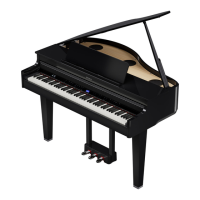19
Creating Your Own Piano Tone (Piano Designer)
Editing the Grand Piano Tone
You can adjust various aspects of the grand piano’s tone, including the string and pedal resonances, and the sound of the hammers striking the strings.
* Only tones belonging to the “Grand” group can be adjusted.
1. Press the [ ] button.
2. Press the [–] [+] buttons to access the “Piano Tone Edit” screen.
3. Press the [ ] knob to conrm.
4. Press the [–] [+] buttons to access the screen of the item that
you want to adjust.
5. Press the [ ] button to conrm, and press the [–] [+] buttons
to select the value of the setting.
6. When you are nished editing the piano tone, press [ ]
button.
A conrmation message appears.
If you decide to cancel, press the [ ] button.
7. Press the [–] [+] buttons to select “Yes”, and press the [ ]
button to execute.
The Grand Piano tone settings are saved.
Items Value Explanation
Piano Tone Edit
Lid 0–6 (default value: 4)
Adjusts the extent to which the top lid of the grand piano is open.
The sound will become more mellow as you close the top lid of the piano in the screen.
The sound will become brighter as you open the top lid of the piano in the screen.
Key O Noise
O, 1–10
(default value: 3)
Adjusts the action noise that is heard when you release a key.
Higher settings produce a louder action noise.
Hammer Noise
-2–0–+2
(default value: 0)
Adjusts the sound produced when the hammer of an acoustic piano strikes the string.
Higher settings will produce a louder sound of the hammer striking the string.
Duplex Scale
O, 1–10
(default value: 2)
Adjusts the sympathetic vibrations of an acoustic piano’s Duplex Scale.
Higher settings will make the sympathetic vibration louder.
The Duplex Scale is a system of sympathetically vibrating strings sometimes included in grand pianos.
These sympathetically vibrating strings are not struck directly with hammers, but sound by vibrating in sympathy
with the vibrations of other strings. By resonating with the overtones, these strings add richness and brilliance to the
sound. These sympathetic strings are added only to the high register above approximately C4. Since they do not have
a damper (a mechanism that stops them from sounding), they will continue sounding even after you play a note and
then release it to stop the sound of the string that was actually struck.
Full Scale String Res.
O, 1–10
(default value: 4)
Adjusts the resonant sound of an acoustic piano (the sound produced by the strings of previously-pressed keys
vibrating in sympathy with newly played notes, or the sound of other strings vibrating in sympathy with the notes you
play while pressing the damper pedal). Higher settings produce louder sympathetic resonance.
Damper Resonance O, 1–10
Adjusts the overall resonance of the acoustic piano when its damper pedal is pressed (the sound of other strings
vibrating in sympathy when you press the damper pedal, and the resonance of the entire instrument).
Higher settings produce louder sympathetic resonance.
Key O Resonance
O, 1–10
(default value: 3)
Adjusts the resonance of the subtle sounds that occur when a key of an acoustic piano is released.
A higher value produces a larger tonal change during the decay.
Cabinet Resonance
O, 1–10
(default value: 4)
Adjusts the body resonance of the grand piano itself.
Higher values will produce a larger body resonance.
Soundboard Type 1–5 (default value: 1)
Selects how the soundboard of the acoustic piano will resonate.
You can choose from ve dierent types of resonance.
Damper Modeling
O, 1–10
(default value: 5)
Adjusts the damper noise of the acoustic piano sound (the sound of the damper releasing the strings when you press
the damper pedal).
Single Note Tuning
(*)
-50.0–0–+50.0
(per key)
Adjusts the tuning of each individual key. For example, you can adjust the width of stretched tuning, which tunes the
higher register slightly higher and the lower register slightly lower.
Single Note Volume
(*)
-50–0 (per key) Adjusts the volume of each key. Lower settings decrease the volume.
Single Note
Character (*)
-5–0–+5 (per key)
Adjusts the tonal character of each key. Higher settings produce a harder sound, and lower settings produce a softer
tone.
* The result of this eect will dier depending on the pitch range.
Reset Setting Resets the “Piano Tone Edit” settings of the selected tone to their factory settings.
Single Note settings (*)
1. Select the Single Note settings screen, and press the [ ] button to conrm.
2. Press the key on the keyboard that you want to select, and press the [–] [+] buttons to edit the value.
3. Press the [ ] button to exit the screen of that item.

